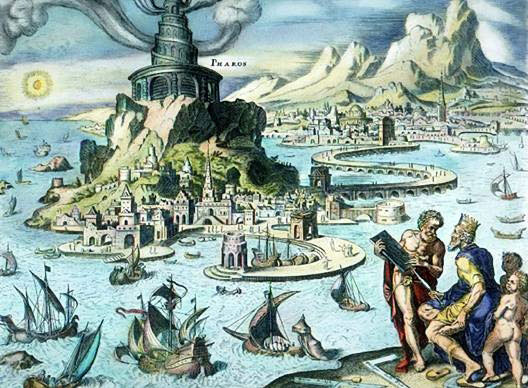Looking to find Alexander the Great Tomb?
The legendary city of Alexandria, the convergence of the seven wonders of the ancient world seems to have been designed to align with the rising sun on the birth of Alexander the Great.
The legendary king of Macedonia, who dominated an empire stretching from Greece to India today, built the ancient city of Alexandria in 331 BC. Later, the city became more prosperous, associated with names such as Queen Cleopatra, the Giant Library of the Royal Library of Alexandria and the lighthouse Alexandria as high as 140 meters, one of the seven wonders of the world.

The new discovery opens up hope for finding the tomb of Alexander the Great
The ancient citadel of Alexandria is planned around the east-west boulevard called Canopic, an archaeologist Giulio Magli of Italy. A new study on this ancient route reveals that it is not built on topography (such as it does not run parallel to the coastline). Instead, right on Alexander the Great's birthday, the 4th century sunrise will be in the 'almost perfectly aligned' way with the road.
The result of this finding could help researchers have more clues to search for the tomb of Alexander the Great, LiveScience said. Ancient texts say that the king's body was placed in a golden coffin and there was an extra layer of golden protection. This mausoleum was built somewhere in Alexandria but has been lost for nearly 2000 years.
Magli and colleagues used computer software to simulate the position of the sun at the time of the 4th century BC (Due to imperfect earth orbit, there were deviations in the sun's movement. through the centuries. Alexander the Great was born on July 20, 356, before the sun under the Julian calendar. This calendar is slightly different from the modern deviation because there is no leap year.
On July 20, the fourth century BC, the researchers found that the sun rose at a point half a degree below the Canopic axis, Magli told LiveScience.
Outside the sun, a second star also makes this natural effect more interesting. The star Regulus, considered to be the King's "Star of Destiny" and lies at the head of the star lions star cluster, also grows in a position almost in line with Canopic Boulevard.
Magli said astronomical architecture planning is very popular in the ancient world. For example, the Great Pyramid of Giza is lined up with surprising accuracy with compass points.
- Found the tomb of Alexander the Great?
- Excavation of the grave involves Alexander the Great in Greece
- Find remains in the mysterious tomb of Alexander the Great
- The mysterious Alexander tomb
- Discovered two female statues in the Amphipolis tomb area
- New assumptions about the relics of Alexander the Great?
- The lesson from Alexander the last wish
- The remains of Father Alexander the Great have been found
- Solution to the mysterious 2,000 years of Alexander the Great's death
- The 'deadly' weapon nearly destroyed Alexander the Great's army
- The tombs are the most mysterious in the world
- The king is proud to conquer more than 5 million km2 on 3 continents
 Discovered an ancient centipede fossil 99 million years old
Discovered an ancient centipede fossil 99 million years old Discovered bat-like dinosaurs in China
Discovered bat-like dinosaurs in China Discovered a 200-year-old bronze cannon of the coast
Discovered a 200-year-old bronze cannon of the coast Discover 305 million-year-old spider fossils
Discover 305 million-year-old spider fossils 9 billion light years away, 'space hole' facing Earthlings
9 billion light years away, 'space hole' facing Earthlings  A tiny bird weighing only 71 grams dares to peck at a hawk's head, but the notorious predator doesn't dare to fight back.
A tiny bird weighing only 71 grams dares to peck at a hawk's head, but the notorious predator doesn't dare to fight back.  Great ways to relieve stress and beat boredom
Great ways to relieve stress and beat boredom  Unexpected discovery of the largest storm lasting 190 years in the Solar System
Unexpected discovery of the largest storm lasting 190 years in the Solar System  Cloth suspected to be the legendary purple cloak of Alexander the Great
Cloth suspected to be the legendary purple cloak of Alexander the Great  Using AI to draw portraits of Leonardo da Vinci, Alexander the Great in the 21st century and the cool ending
Using AI to draw portraits of Leonardo da Vinci, Alexander the Great in the 21st century and the cool ending 